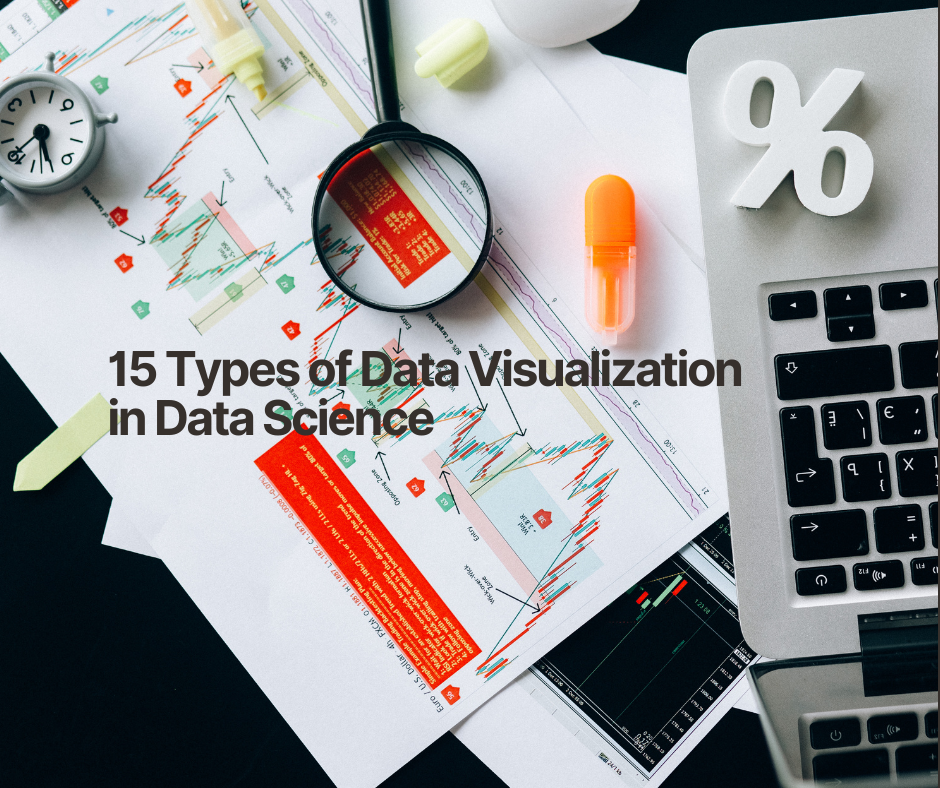15 Types of Data Visualization in Data Science
 Ruhi Parveen
Ruhi Parveen
Data visualization is a fundamental aspect of data science, helping to transform complex data sets into understandable and actionable insights. Effective visualizations allow data scientists and analysts to communicate findings clearly, uncover patterns, and make informed decisions. Here are 15 types of data visualization that are commonly used in data science:
1. Bar Charts
Bar charts are a common type of data visualization used to display and compare the frequency, count, or other measures (e.g., sum, average) of categorical data. They are particularly effective for showing comparisons among discrete categories.
Use Cases:
Comparing sales figures across different regions
Displaying survey results
Showing the frequency of different categories
2. Line Charts
Line charts display data points connected by straight lines, making them perfect for showing trends over time. They help visualize changes and trends in continuous data.
Use Cases:
Tracking stock prices over time
Monitoring website traffic
Visualizing temperature changes
3. Pie Charts
Pie charts represent data as slices of a circle, with each slice proportional to the value it represents. They are best used for showing the composition of a whole.
Use Cases:
Displaying market share distribution
Showing budget allocations
Illustrating survey results
4. Histograms
A histogram is a graphical representation of the distribution of a dataset. It is an estimate of the probability distribution of a continuous variable. Histograms are used to summarize discrete or continuous data that are measured on an interval scale.
Use Cases:
Analyzing the distribution of exam scores
Visualizing the age distribution of a population
Exploring the distribution of salaries within a company
5. Scatter Plots
A scatter plot is a type of data visualization that displays values for typically two variables for a set of data. These plots are useful in determining the relationship between two different variables and identifying patterns, trends, and potential correlations. Scatter plots are often used in statistical analysis and are a fundamental tool for data scientists and analysts.
Use Cases:
Examining the relationship between advertising spend and sales
Analyzing the correlation between height and weight
Exploring the relationship between temperature and energy consumption
6. Heatmaps
Heatmaps are a powerful visualization tool used to represent data density across a two-dimensional space. They are particularly useful in highlighting patterns, trends, and variations within complex datasets.
Use Cases:
Visualizing correlation matrices
Showing website click-through rates
Analyzing the frequency of events over time
7. Box Plots
Box plots, or whisker plots, display the distribution of a dataset based on five summary statistics: minimum, first quartile, median, third quartile, and maximum. They help identify outliers and the spread of data.
Use Cases:
Comparing test scores across different classes
Analyzing the distribution of salaries in different departments
Visualizing the spread of delivery times
8. Area Charts
Area charts are similar to line charts but have the area below the line filled in with color. They are used to represent cumulative totals over time.
Use Cases:
Showing revenue growth over time
Visualizing the composition of market segments over time
Illustrating cumulative sales figures
9. Bubble Charts
Bubble charts are a variation of scatter plots where the data points are replaced with bubbles. The size of each bubble represents a third variable, adding an extra dimension to the data.
Use Cases:
Comparing market growth potential
Analyzing product performance across different dimensions
Visualizing demographic data
10. Tree Maps
Tree maps display hierarchical data using nested rectangles. The size and color of each rectangle represent different variables.
Use Cases:
Visualizing the structure of a large organization
Analyzing portfolio allocation
Showing the composition of website traffic sources
11. Gantt Charts
Gantt charts are used to represent project schedules. They display tasks or activities along a timeline, showing start and end dates.
Use Cases:
Project management
Planning construction timelines
Scheduling marketing campaigns
12. Waterfall Charts
Waterfall charts are used to show the cumulative effect of sequentially introduced positive or negative values. They help in understanding the incremental changes in data.
Use Cases:
Financial analysis
Visualizing changes in profit and loss statements
Analyzing revenue and expense changes
13. Radar Charts
Radar charts, or spider charts, display multivariate data on a two-dimensional plane. Each axis represents a different variable, and data points are connected to form a polygon.
Use Cases:
Comparing product features
Visualizing skill levels across different areas
Analyzing performance metrics
14. Funnel Charts
Funnel charts are used to represent stages in a process. They show how data progresses through different stages and help identify potential bottlenecks.
Use Cases:
Sales conversion analysis
Visualizing customer journey stages
Analyzing drop-off rates in a process
15. Sankey Diagrams
Sankey diagrams represent flows of resources or information. They use arrows of varying widths to show the magnitude of flows between nodes.
Use Cases:
Energy flow analysis
Visualizing website navigation paths
Analyzing financial transfers
Conclusion
Data visualization is a powerful tool in data science, enabling the transformation of raw data into meaningful insights. By selecting the appropriate type of visualization, data scientists can effectively communicate their findings, highlight key patterns, and support decision-making processes. Each type of visualization has its strengths and best-use scenarios, making it crucial to choose the right one based on the specific data and the story you want to tell. For those looking to master data science skills, finding the best Data Science course in Patna, Delhi, Noida, Mumbai, Indore, and other parts of India is essential.
Subscribe to my newsletter
Read articles from Ruhi Parveen directly inside your inbox. Subscribe to the newsletter, and don't miss out.
Written by

Ruhi Parveen
Ruhi Parveen
I am a Digital Marketer and Content Marketing Specialist, I enjoy technical and non-technical writing. I enjoy learning something new.